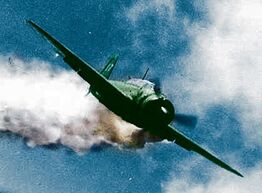The Yokosuka D4Y Suisei was a dive bomber that was used by Japan during World War II.
Description[]
The first D4Y1 Model 11 used an Aichi AE1A Atsuta 12 Engine which was based upon a Daimler-Benz DB 600G engine imported from Germany for testing purposes. It could propel the aircraft at a top speed of up to 575 kilometers per hour.[2] The operational range of the D4Y1 was about 1,520 kilometers, though this could be greatly expanded by the use of detachable drop tanks. The service ceiling of the aircraft meanwhile was limited to 9,900 meters. For armament, the D4Y1 had two 7.7mm machine guns mounted in the nose, one rearward firing 7.92mm machine gun in the rear cockpit, and up to 500 kilograms worth of bombs.
The total weight of the D4Y1 was about 2,440 kilograms with a total length of 10.2 meters and wingspan of 11.5 meters.[3] Overall, the performance of the D4Y1 was quite good, giving it several key advantages in combat. However, issues with the engine would only serve to delay the production and distribution of the D4Y.
Variants[]
The first variant of the D4Y series was the D4Y-1C reconnaissance conversion which in fact came prior to the Model 11 version. Following came the improved D4Y2 Model 12 now with Aichi Atsuta 32 Engine with an additional 200 horsepower. While the performance of the D4Y2 was excellent, the lack of protection for crew and aircraft would prove costly to the Japanese war effort. The D4Y2-S was a night fighter conversion of the base dive bomber model which mounted a 20mm autocannon in a Schräge Musik configuration, though it did not have much success against the B-29 bombing raids. The D4Y2a model was the first to be fitted with the 13.1mm machine gun in the rear cockpit.
The D4Y3 model was notable for having been fitted with a Kinsei 62 radial engine which greatly changed the design of the aircraft. The decision to move towards a radial design came out of Japan's long running experience and trust of the air-cooled design, compared to the relatively foreign and untested inline engine. In fact, the D4Y is the only Japanese aircraft besides the Kawasaki Ki-61 to use an inline engine. While the view from the cockpit worsened and thus hampered carrier operations. However, the gained reliability of the D4Y with no worsened performance than the prior D4Y2 meant that the D4Y3 was accepted promptly.

A D4Y Kamikaze going down in flames
The D4Y3a model was similar to its base model save for the implementation of the 13mm machine gun. The final variant of the series was the D4Y4 which was specialized specifically for Kamikaze operations. It was equipped with 800 kilograms worth of bombs. The D4Y4 also had a provision for three RATO units and was developed in 1944. Also produced alongside the standard line of development were the D4Y1 KAI and D4Y2 KAI conversions which were modified so that they could be catapult launched from smaller carriers and even battleships.
History[]
The D4Y dive bomber was first developed in 1938 when the Japanese military had purchased an example Heinkel He 118 prototype for their designers to experiment with. Even when the prototype had been destroyed, the standard for a new Japanese dive bomber had been set. The Yokosuka development team thusly accepted the project and created a much smaller aircraft than their German base. The prototype first flew in December of 1940 with the first limited production run examples reaching carriers in 1942. However, the first pre-production D4Ys had the problem of suffering severe damage to their wing spars in a dive and thus the series shifted into a reconnaissance role instead of its original dive bomber role. However, eventually the D4Y was issued in large numbers to Japanese carrier groups.
Notably, many D4Y dive bombers became victim to more advanced American aircraft and pilots during the "Great Marianas Turkey Shoot". By the time that the Battle of Leyte Gulf had come, many D4Ys were merged into groups with various other aircraft such as the A6M Zero for Kamikaze operations. In total, some 2,000 D4Ys had been built during World War II.
References[]
| |||||||||||||||||
